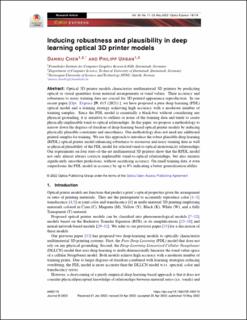| dc.contributor.author | Chen, Danwu | |
| dc.contributor.author | Urban, Philipp | |
| dc.date.accessioned | 2023-01-18T12:50:50Z | |
| dc.date.available | 2023-01-18T12:50:50Z | |
| dc.date.created | 2022-05-19T13:43:57Z | |
| dc.date.issued | 2022 | |
| dc.identifier.citation | Optics Express. 2022, 30 (11), 18119-18133. | en_US |
| dc.identifier.issn | 1094-4087 | |
| dc.identifier.uri | https://hdl.handle.net/11250/3044319 | |
| dc.description.abstract | Optical 3D printer models characterize multimaterial 3D printers by predicting optical or visual quantities from material arrangements or tonal values. Their accuracy and robustness to noisy training data are crucial for 3D printed appearance reproduction. In our recent paper [Opt. Express 29, 615 (2021) [CrossRef] ], we have proposed a pure deep learning (PDL) optical model and a training strategy achieving high accuracy with a moderate number of training samples. Since the PDL model is essentially a black-box without considering any physical grounding, it is sensitive to outliers or noise of the training data and tends to create physically-implausible tonal-to-optical relationships. In this paper, we propose a methodology to narrow down the degrees-of-freedom of deep-learning based optical printer models by inducing physically plausible constraints and smoothness. Our methodology does not need any additional printed samples for training. We use this approach to introduce the robust plausible deep learning (RPDL) optical printer model enhancing robustness to erroneous and noisy training data as well as physical plausibility of the PDL model for selected tonal-to-optical monotonicity relationships. Our experiments on four state-of-the-art multimaterial 3D printers show that the RPDL model not only almost always corrects implausible tonal-to-optical relationships, but also ensures significantly smoother predictions, without sacrificing accuracy. On small training data, it even outperforms the PDL model in accuracy by up to 8% indicating a better generalization ability. | en_US |
| dc.language.iso | eng | en_US |
| dc.publisher | Optica Publishing Group | en_US |
| dc.rights | Navngivelse 4.0 Internasjonal | * |
| dc.rights.uri | http://creativecommons.org/licenses/by/4.0/deed.no | * |
| dc.title | Inducing robustness and plausibility in deep learning optical 3D printer models | en_US |
| dc.title.alternative | Inducing robustness and plausibility in deep learning optical 3D printer models | en_US |
| dc.type | Peer reviewed | en_US |
| dc.type | Journal article | en_US |
| dc.description.version | publishedVersion | en_US |
| dc.source.pagenumber | 18119-18133 | en_US |
| dc.source.volume | 30 | en_US |
| dc.source.journal | Optics Express | en_US |
| dc.source.issue | 11 | en_US |
| dc.identifier.doi | 10.1364/OE.455115 | |
| dc.identifier.cristin | 2025666 | |
| cristin.ispublished | true | |
| cristin.fulltext | original | |
| cristin.qualitycode | 2 | |

